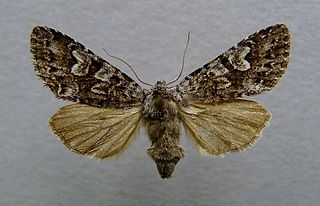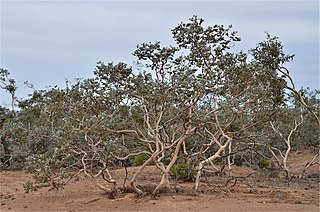
The beet armyworm or small mottled willow moth is one of the best-known agricultural pest insects. It is also known as the asparagus fern caterpillar. It is native to Asia, but has been introduced worldwide and is now found almost anywhere its many host crops are grown. The voracious larvae are the main culprits. In the British Isles, where it is an introduced species and not known to breed, the adult moth is known as the small mottled willow moth.

The glaucous-winged gull is a large, white-headed gull. The genus name is from Latin Larus which appears to have referred to a gull or other large seabird. The specific glaucescens is New Latin for "glaucous" from the Ancient Greek, glaukos, denoting the grey color of its wings.
Glaucous is used to describe the pale grey or bluish-green appearance of the surfaces of some plants, as well as in the names of birds, such as the glaucous gull, glaucous-winged gull, glaucous macaw, and glaucous tanager.
Syngropia is a monotypic moth genus of the family Crambidae described by George Hampson in 1912. Its one species, Syngropia stictica, described in the same article, is found in Guatemala.

Papestra biren, the glaucous shears, is a moth of the family Noctuidae. The species was first described by Johann August Ephraim Goeze in 1781. It is found in most of Europe, but not in the southern parts of the Iberian Peninsula, Italy and Greece. Outside of Europe it is found in Kashmir and through the Palearctic to Siberia, Central Asia, Amur, Kamchatka, the Russian Far East and Japan. It was introduced in Newfoundland in 1935 and has since then extended its range ever more southward within North America partly overlapping with Papestra quadrata(Smith, 1891). It rises to 2200 m above sea level in the Alps.

Eucalyptus gillii, known as the curly mallee, Arkaroola mallee, or silver mallee, is a species of mallee or small tree that is endemic to inland Australia. It has smooth bark, sometimes with rough bark near the base, often only juvenile, usually glaucous leaves in the crown, flower buds in groups of between seven and eleven, pale yellow flowers and barrel-shaped or shortened spherical fruit.

Variations of gray or grey include achromatic grayscale shades, which lie exactly between white and black, and nearby colors with low colorfulness. A selection of a number of these various colors is shown below.
Halysidota eudolobata is a moth of the family Erebidae. It was described by George Hampson in 1901. It is found in the Amazon region.
Trichromia phaeocrota is a moth in the family Erebidae. It is found in French Guiana and Venezuela.
Clupeosoma atristriata is a moth in the family Crambidae. It was described by George Hampson in 1917. It is found in Papua New Guinea, including the Bismarck Archipelago and Indonesia, where it has been recorded from Timur.
Clupeosoma glaucinalis is a moth in the family Crambidae. It was described by George Hampson in 1917. It is found in Singapore and Indonesia, where it has been recorded from Sumbawa.
Clupeosoma rufistriata is a moth in the family Crambidae. It was described by George Hampson in 1917. It is found in New Guinea.
Aiyura pyrostrota is a moth in the family Crambidae. It was described by George Hampson in 1912. It is found in Papua New Guinea.
Proleucinodes melanoleuca is a moth in the family Crambidae. It was described by George Hampson in 1913. It is found in Peru.
Syllepte methyalinalis is a moth in the family Crambidae. It was described by George Hampson in 1912. It is found in Guyana.
Syllepte microdontalis is a moth in the family Crambidae. It was described by George Hampson in 1912. It is found in French Guiana.
Syllepte chalybifascia is a moth in the family Crambidae. It was described by George Hampson in 1896. It is found in India (Nagas).
Syllepte dinawa is a moth in the family Crambidae. It was described by George Hamilton Kenrick in 1912. It is found in Papua New Guinea.
Tyspanodes creaghi is a moth in the family Crambidae. It was described by George Hampson in 1898. It is found on Borneo and in Papua New Guinea and Australia, where it has been recorded from Queensland.
Udea binoculalis is a moth in the family Crambidae. It was described by George Hampson in 1904. It is found on the Bahamas.



